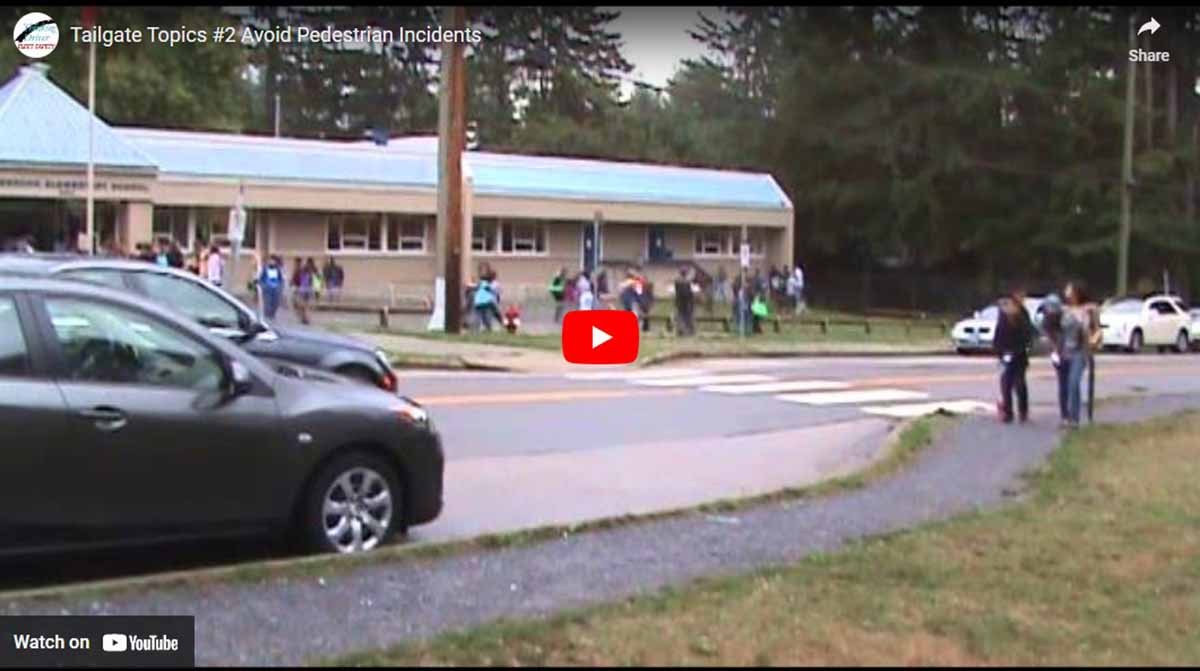Safety Meeting Planner & Agenda
Watch Out for Pedestrians!
Meeting Leader:
- Prepare in advance to make this meeting effective.
- Print and read over this entire agenda.
- Think about how you want to lead the meeting.
- Is there anything that is specific to your company or operation that you can include to personalize the information?
- Review the video for this session.
- Save the link to the video in your ‘Favourites’ folder on your browser for easy access.
- Open and then minimize the viewer just before the meeting to make the video introduction smooth.
Start Your Meeting!
Opening Statement:
Pedestrians are the most vulnerable road users. Every year in the US and Canada, over 5,000 pedestrians are killed in traffic accidents.
Questions for this Meeting:
Q: Where do most pedestrian collisions occur, small towns or larger cities?
Answer:
About two-thirds of pedestrian fatalities occur urban areas.
Q: What two days of the year do you think are the worst for pedestrian fatalities?
Answer:
New Year’s Day and Halloween are the two most deadly days of the year, having the highest number of pedestrian fatalities.
Q: What is the most dangerous time of the day for pedestrians?
Answer:
Pedestrians are more likely to be killed in a crash between 3 am and 6 am or during the weekend on Saturday and Sunday.
Q: Who is more likely to be killed as a pedestrian, men or women, older or younger people?
Answers:
Males have a much higher probability than females to be killed in a crash.
The older age group (over 64) has a much greater possibility than other age groups to be killed in a crash.
Q: Does drinking play a role?
Answer:
It’s no surprise that as a pedestrian’s blood alcohol concentration (BAC) increases, the probability of them getting killed in a crash increases.
Q: What impact does lighting play?
Answers:
Pedestrians have a higher probability to be killed in a crash under a dark condition than under other lighter conditions.
As drivers, we are usually on the lookout for other vehicles and are often surprised by their movements. Pedestrians can be even more unpredictable and we need to be prepared and watch for them. It’s up to you to look out for pedestrians and take early action to avoid conflicts.
Tailgate Tips:
Remember the 5 Fundamentals and apply them to pedestrian safety.
Think and Look Ahead
- Use your eyes to actively search for pedestrians, especially in urban areas where they are numerous. Look well ahead, at least 12 to 15 seconds, and move your eyes from sidewalk to sidewalk to make sure that you don’t have a tunnel vision effect and miss seeing a pedestrian. At night be particularly attentive as many pedestrians unwisely choose dark clothing that makes them difficult to see.
- Make sure that you shoulder check before turning because pedestrians are easy to miss when they are in your blind spot.
Anticipate Hazards
- Once you see a pedestrian, anticipate and predict what they MAY do. And be prepared to respond as needed.
- When you are stopped for pedestrians, watch for vehicles coming from behind you in other lanes that may not see the walker and honk your horn to alert the pedestrians if you think that the other driver isn’t stopping. If it’s in the driver’s side lane, and you have time, stick your hand out the window to attract the other driver’s attention.
- Avoid stopping mid-block to invite pedestrians to cross. Other drivers don’t expect this and may either not stop for the pedestrian or hit you from behind.
Keep Your Options Open
- Be aware of other vehicles around you and your option to change lanes or slow or stop if you need to avoid a pedestrian.
- Look left and right before entering an intersection to make sure that there are no ‘late running’ pedestrians.
- Yield to pedestrians in crosswalk and anywhere else that they may be in danger from your vehicle.
- Stop well back from crosswalks so that you can see pedestrians and have a safety cushion in case you are rear ended and pushed forward.
Manage the Risk
- If you are in any doubt about a pedestrian and his or her movements, cover the brake and reduce your speed. Sometimes a pedestrian will be distracted or impaired and step out without looking.
- If you are able, make eye contact with pedestrians and if you are unsure if they see you or not, tap the horn gently to attract their attention.
Control with Finesse
- Steer and brake smoothly if you need to avoid a pedestrian. Jerking the steering wheel or slamming the brakes will only make matters worse if you lose control!
Keep Yourself and Your Family Safe
When on foot and near traffic:
- Teach your kids pedestrian safety from a young age and be a good example for them!
- Look both ways before crossing.
- Use the crosswalk.
- Walk on the left, facing traffic.
- Wear light coloured clothing.
- If you walk for exercise or on dark roads, wear a reflective vest or jacket.
- Stay well off the roadway, particularly at night.
- If you work near moving vehicles of any type on or off the highway, wear your Personal Protective Equipment (PPE) and avoid turning your back on moving vehicles.
Introduce the Video:
Spencer McDonald discusses how to prevent vehicle incidents involving pedestrians.
Practical Challenge:
This week, look for pedestrians and make sure that you yield when required to. Notice how many close calls there are between vehicles and pedestrians and make sure that you are not one of them.









